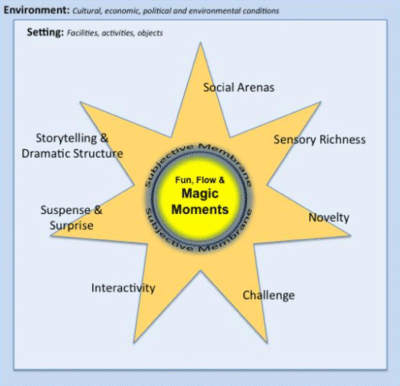
Vol. XV, No. 1, January 2015
- Editor's corner
- There's still time to register for FEC education for success
- Understanding the value of experiences
- Paper trumps plastic
- Immersive experiences continue as major trend with escape games
- A paradigmatic shift for entertainment venues; the entertainment is now secondary
- The changing American family
- Feasibility studies aren't what they used to be
- Why spending on tech equipment is so appealing
- Beer preferences
- Beer pong goes high-tech
Understanding the value of experiences
In Western economies, rather than an economy made up of mostly tangible goods, 2/3s of the economy is made up of intangible offerings - services and experiences. The growth of experiences as a distinct offering with higher perceived value than goods, products or services was first identified by Pine and Gilmore back in 1999 with the publication of their book, The Experience Economy.
Although there was never any doubt that consumers value commercial experiences, including entertainment ones, there has never been a clear understanding of what motivates us to pay for experiences that stimulate our senses, emotions and intellect. We now have researcher Susanne Poulsson at the BI Norwegian Business School to thank for providing the answers.
Poulsson studied 15 very different attractions and activities of tourism and travel, art and culture, entertainment, leisure and play in five countries and conducted in-depth interviews with participants to uncover and identify the underlying factors and mechanisms that create value for commercial experiences.
According to Poulssen's findings, experience offerings have three main characteristics:
- A promise of pleasure, flow and magical moments
- The need for physical and mental presence
- A co-creation process of interaction between the consumer and the experience offering.
A visitor invests time and is involved in creating the experience. The magic is created in the interaction between the external stimuli and how each visitor perceives them. This is a personal and subjective process. For this reason, different visitors might see the same experience in very different lights.
Poulsson identified the seven factors that create experience value for a visitor:
- The social setting. The social aspects promote and enhance experience values. For example there might be interaction and a sense of belonging. Being present with others and feeling that one belongs together by sharing an experience will increase its value.
- Sensory richness. Varied, intense and unusual stimuli of many senses promote and enhance the experience value.
- Novelty. New and different things help promote and enhance the experience value.
- Challenge. Elements that challenge the visitor promote the experience value. Such challenges might be tasks that are hard, but not impossible to solve.
- Participation and interaction. The experience value increases when the visitor is allowed to join in the game (interaction). This might be through direct participation, an opportunity to impact and receive feedback on how he or she did.
- Suspense and surprise. Suspense and surprises evoke and enhance experience values. This might be done by building up expectations and then meeting them.
- Storytelling and dramatic structure. Devices such as plot, character, conflict and message provide structure and context and give meaning to events and factual information. This promotes and strengthens the experience.
Susanne Poulsson's Star Experience Model
Poulssen says an experience does not need a top score for all the seven dimensions to create a brilliant experience. “But you need a high score and you must provide something out of the ordinary in at least one of these dimensions in order to offer something that actually creates value for your customer.”
Poulssen's seven experience values help to explain some of the trends we are seeing in entertainment. For example, the declining per capita attendance at movie theaters and the increasing viewing of movies at home and on mobile screens may in fact be due to more than just convenience and economics. It's hard to be social with families or friends when you are sitting in a movie theater, as you can't talk or even text. However, at home you can. So the social setting of watching movies at home with someone or texting with a friend who is also watching, but at another location, adds a social value dimension to movie viewing that can't be found in the cinema.
It also helps to explain the growing importance of food and beverage offerings at entertainment-oriented venues. Food and beverage adds sensory richness and discovering new flavors of foods and drinks adds novelty to what could otherwise become a very familiar entertainment experience.
The well executed values of social setting, sensory richness and novelty, as well as the challenge and participation in the recreation/entertainmentat TopGolf and Punch Bowl Social (see this issue's article A paradigmatic shift for entertainment venues) definitely are contributing to their successes, as they have been able to score high on a number of experience values.
Vol. XV, No. 1, January 2015
- Editor's corner
- There's still time to register for FEC education for success
- Understanding the value of experiences
- Paper trumps plastic
- Immersive experiences continue as major trend with escape games
- A paradigmatic shift for entertainment venues; the entertainment is now secondary
- The changing American family
- Feasibility studies aren't what they used to be
- Why spending on tech equipment is so appealing
- Beer preferences
- Beer pong goes high-tech


